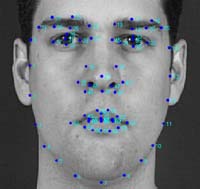



The XM2VTS frontal data set contains 2360 mug shots of 295 individuals collected over 4 sessions. More information on the data set can be found at:-
http://www.ee.surrey.ac.uk/Research/VSSP/xm2vtsdb/
Example images are shown below:-

|

|

|

|
| egs1 | egs2 | egs3 | egs4 |
The XM2VTS data set is supplied with manually located eye points for all 2360 images. These points files can be obtained from the University of Surrey web site, here.
However to enable more detailed testing and model building the XM2VTS markup has been expanded to landmarking 68 facial features on each face. The 68 points chosen are consistent across all images. The landmark scheme is shown below:-

|
Click on the image or here to see a larger version of this image |
It is intended that these marked up point will be used for a variety of purposes:-
Facial Feature Finding - The markup provides ground truth to test automatic face and facial feature finding software.
Face Model Building - Sophisticated object models, such as the Active Appearance Model approach require manually labelled data, with consistent corresponding points as training data.
Face Recognition/Verification - The marked up points could be used to test face recognition or verification performance, when the exact location of the face and features are known (i.e. removing the registration error)
Currently the full 68 point markup is available for sessions 1-4.
The filenames of the XM2VTS images have the following format:-
XXX_Y_Z.ppm
Here:-
The image files and point files have corresponding names. e.g. "000_1_1.ppm" has points in file "000_1_1.pts"
The points file format is as follows:-
version: 1 (This points file version no. can be ignored)
image_size_x: 720 (The image width in pixels)
image_size_y: 576 (The image height in pixels)
n_points: 68 (The number of labelled points on the image)
{
xxxx yyyy
.....
}
For each point xxxx is the x co-ord starting from the top-left corner and yyyy is the y co-ord similarly starting from the top-left corner of the image.
All points files contain 68 points with each point representing a specific point on the face (see diagram above).